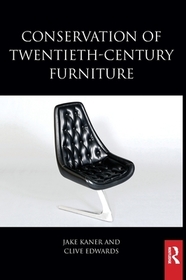
Conservation of Twentieth-Century Furniture
Sorozatcím: Routledge Series in Conservation and Museology;
-
20% KEDVEZMÉNY?
- A kedvezmény csak az 'Értesítés a kedvenc témákról' hírlevelünk címzettjeinek rendeléseire érvényes.
- Kiadói listaár GBP 215.00
-
102 716 Ft (97 825 Ft + 5% áfa)
Az ár azért becsült, mert a rendelés pillanatában nem lehet pontosan tudni, hogy a beérkezéskor milyen lesz a forint árfolyama az adott termék eredeti devizájához képest. Ha a forint romlana, kissé többet, ha javulna, kissé kevesebbet kell majd fizetnie.
- Kedvezmény(ek) 20% (cc. 20 543 Ft off)
- Kedvezményes ár 82 173 Ft (78 260 Ft + 5% áfa)
Iratkozzon fel most és részesüljön kedvezőbb árainkból!
Feliratkozom
102 716 Ft

Beszerezhetőség
Becsült beszerzési idő: A Prosperónál jelenleg nincsen raktáron, de a kiadónál igen. Beszerzés kb. 3-5 hét..
A Prosperónál jelenleg nincsen raktáron.
Why don't you give exact delivery time?
A beszerzés időigényét az eddigi tapasztalatokra alapozva adjuk meg. Azért becsült, mert a terméket külföldről hozzuk be, így a kiadó kiszolgálásának pillanatnyi gyorsaságától is függ. A megadottnál gyorsabb és lassabb szállítás is elképzelhető, de mindent megteszünk, hogy Ön a lehető leghamarabb jusson hozzá a termékhez.
A termék adatai:
- Kiadás sorszáma 1
- Kiadó Routledge
- Megjelenés dátuma 2024. október 11.
- ISBN 9780750656023
- Kötéstípus Keménykötés
- Terjedelem424 oldal
- Méret 246x189 mm
- Súly 940 g
- Nyelv angol
- Illusztrációk 13 Illustrations, black & white; 65 Illustrations, color; 13 Halftones, black & white; 65 Halftones, color; 12 Tables, black & white 603
Kategóriák
Rövid leírás:
Conservation of 20th Century Furniture provides a comprehensive coverage of materials and techniques that are encountered in twentieth-century furniture, through both a contextual point of view and a range of practice perspectives.
TöbbHosszú leírás:
Conservation of Twentieth-Century Furniture provides comprehensive and accessible coverage of the materials and techniques that are encountered in furniture of this century.
After putting the design, manufacture and conservation of twentieth-century furniture into context, the volume then offers an A-Z of materials organised into 12 chapters. Within each chapter a wide variety of material types are discussed, observed, analysed and contextualised, and a list of further sources is provided. The furniture discussed in this book ranges from designer craftsman, individually made pieces, to factory-produced batch items, and includes cabinet work, decoration, surface finishes and upholstery, observing the traditional repertoire of materials, as well as innovative materials and processes introduced over the course of this century. Following the material chapters, the book also includes brief case studies that illustrate some examples of twentieth-century furniture conservation, with a focus on metal, plastic and wood.
Conservation of Twentieth-Century Furniture is the primary resource for those working on the manufacture, history and care of furniture of this period, including conservators, curators, dealers and collectors.
TöbbTartalomjegyzék:
1. Introduction; 2. Overview of Twentieth-Century Furniture Design and Manufacture; 3. Overview of Twentieth-Century Furniture Conservation; 4. Introduction to Adhesives; 5. Board Materials; 6. Composites; 7. Metals; 8. Plant Materials; 9. Natural and Semi-Synthetic Plastics; 10. Synthetic Plastics ; 11. Stones and Minerals; 12. Structural Upholstery; 13. Surface Coatings; 14. Textiles and Fibres; 15. Timber and Related Products; 16. Case Studies of Specific Conservation Models; 17. Conclusion.
Több




